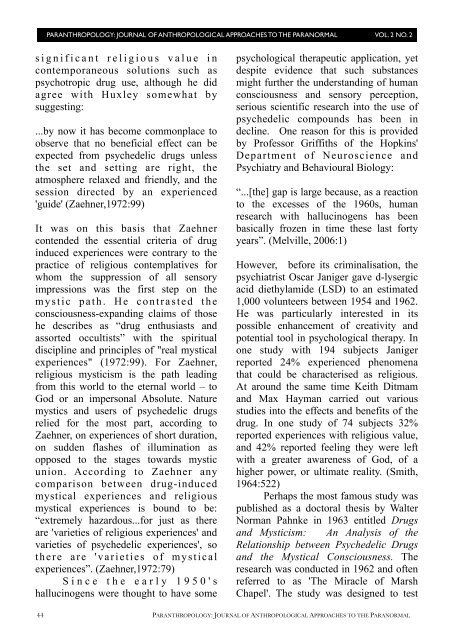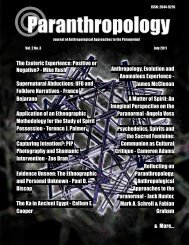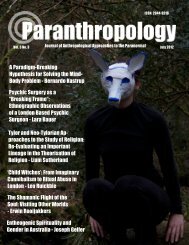Psi and Psychedelics - Paranthropology - Weebly
Psi and Psychedelics - Paranthropology - Weebly
Psi and Psychedelics - Paranthropology - Weebly
Create successful ePaper yourself
Turn your PDF publications into a flip-book with our unique Google optimized e-Paper software.
PARANTHROPOLOGY: JOURNAL OF ANTHROPOLOGICAL APPROACHES TO THE PARANORMAL VOL. 2 NO. 2<br />
s i g n i f i c a n t r e l i g i o u s v a l u e i n<br />
contemporaneous solutions such as<br />
psychotropic drug use, although he did<br />
agree with Huxley somewhat by<br />
suggesting:<br />
...by now it has become commonplace to<br />
observe that no beneficial effect can be<br />
expected from psychedelic drugs unless<br />
the set <strong>and</strong> setting are right, the<br />
atmosphere relaxed <strong>and</strong> friendly, <strong>and</strong> the<br />
session directed by an experienced<br />
'guide' (Zaehner,1972:99)<br />
It was on this basis that Zaehner<br />
contended the essential criteria of drug<br />
induced experiences were contrary to the<br />
practice of religious contemplatives for<br />
whom the suppression of all sensory<br />
impressions was the first step on the<br />
mystic path. He contrasted the<br />
consciousness-exp<strong>and</strong>ing claims of those<br />
he describes as “drug enthusiasts <strong>and</strong><br />
assorted occultists” with the spiritual<br />
discipline <strong>and</strong> principles of "real mystical<br />
experiences" (1972:99). For Zaehner,<br />
religious mysticism is the path leading<br />
from this world to the eternal world – to<br />
God or an impersonal Absolute. Nature<br />
mystics <strong>and</strong> users of psychedelic drugs<br />
relied for the most part, according to<br />
Zaehner, on experiences of short duration,<br />
on sudden flashes of illumination as<br />
opposed to the stages towards mystic<br />
union. According to Zaehner any<br />
comparison between drug-induced<br />
mystical experiences <strong>and</strong> religious<br />
mystical experiences is bound to be:<br />
“extremely hazardous...for just as there<br />
are 'varieties of religious experiences' <strong>and</strong><br />
varieties of psychedelic experiences', so<br />
there are 'varieties of mystical<br />
experiences”. (Zaehner,1972:79)<br />
Since the early 1950's<br />
hallucinogens were thought to have some<br />
psychological therapeutic application, yet<br />
despite evidence that such substances<br />
might further the underst<strong>and</strong>ing of human<br />
consciousness <strong>and</strong> sensory perception,<br />
serious scientific research into the use of<br />
psychedelic compounds has been in<br />
decline. One reason for this is provided<br />
by Professor Griffiths of the Hopkins'<br />
Department of Neuroscience <strong>and</strong><br />
Psychiatry <strong>and</strong> Behavioural Biology:<br />
“...[the] gap is large because, as a reaction<br />
to the excesses of the 1960s, human<br />
research with hallucinogens has been<br />
basically frozen in time these last forty<br />
years”. (Melville, 2006:1)<br />
However, before its criminalisation, the<br />
psychiatrist Oscar Janiger gave d-lysergic<br />
acid diethylamide (LSD) to an estimated<br />
1,000 volunteers between 1954 <strong>and</strong> 1962.<br />
He was particularly interested in its<br />
possible enhancement of creativity <strong>and</strong><br />
potential tool in psychological therapy. In<br />
one study with 194 subjects Janiger<br />
reported 24% experienced phenomena<br />
that could be characterised as religious.<br />
At around the same time Keith Ditmam<br />
<strong>and</strong> Max Hayman carried out various<br />
studies into the effects <strong>and</strong> benefits of the<br />
drug. In one study of 74 subjects 32%<br />
reported experiences with religious value,<br />
<strong>and</strong> 42% reported feeling they were left<br />
with a greater awareness of God, of a<br />
higher power, or ultimate reality. (Smith,<br />
1964:522)<br />
Perhaps the most famous study was<br />
published as a doctoral thesis by Walter<br />
Norman Pahnke in 1963 entitled Drugs<br />
<strong>and</strong> Mysticism: An Analysis of the<br />
Relationship between Psychedelic Drugs<br />
<strong>and</strong> the Mystical Consciousness. The<br />
research was conducted in 1962 <strong>and</strong> often<br />
referred to as 'The Miracle of Marsh<br />
Chapel'. The study was designed to test<br />
44 PARANTHROPOLOGY: JOURNAL OF ANTHROPOLOGICAL APPROACHES TO THE PARANORMAL




